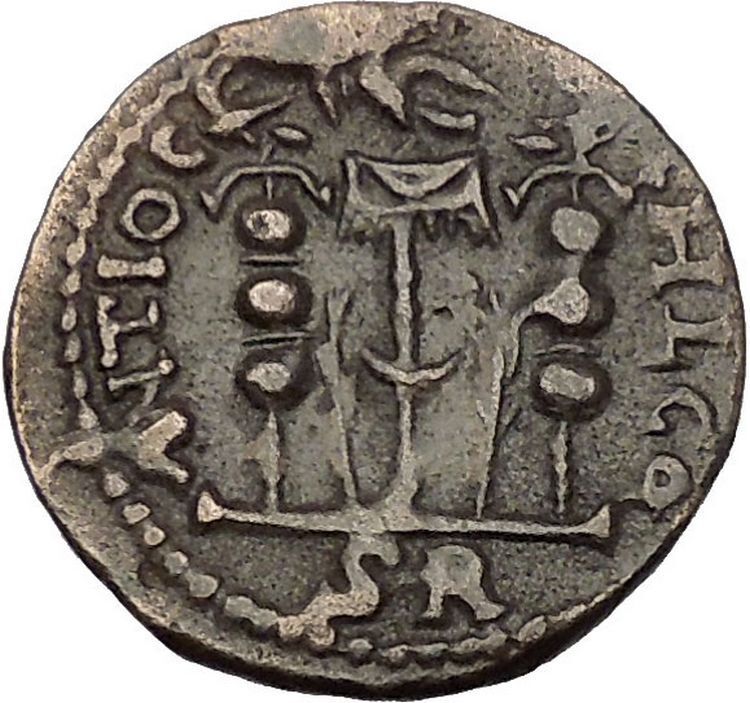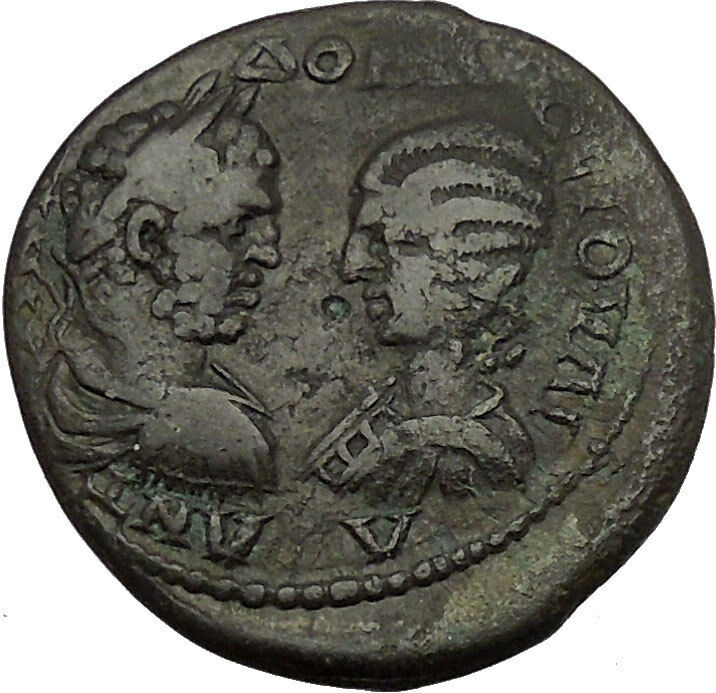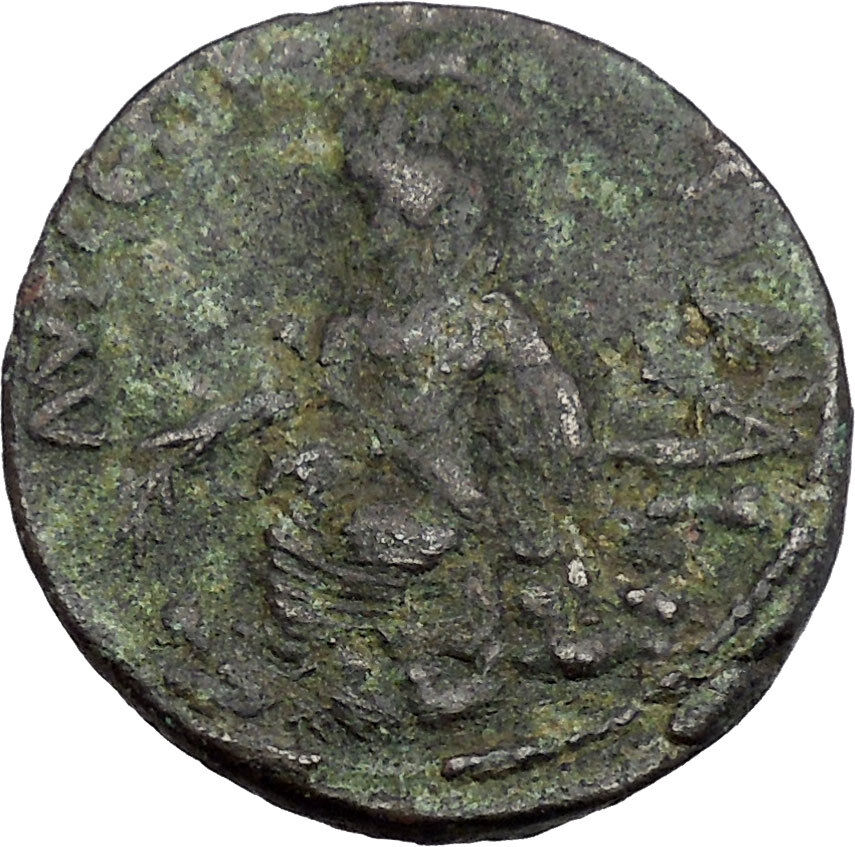|
Septimius Severus
–
Roman Emperor
: 193-211 A.D. –
Bronze 22mm (4.46 grams)
of
Marcianopolis
in Moesia Inferior
Laureate, draped and cuirassed bust right.
MAPKIANOΠOΛITΩN,
Hercules wrestling with the
Nemean Lion as per his First Labor.
(Nemean Lion was the Leo astrological symbol)
You are bidding on the exact
item pictured, provided with a Certificate of Authenticity and Lifetime
Guarantee of Authenticity.
Hercules
wrestling with the
Nemean Lion
(the astrological zodiac sign of
Leo and the constellation).
Nemean Lion
(the astrological zodiac sign of
Leo and the constellation) standing left.
Nemean Lion
(the astrological zodiac sign of
Leo and the constellation) standing right.
Hercules, made temporarily insane by the goddess Hera,
murdered his wife and children. Once recovered, and distressed by his actions,
Hercules consulted the
_01.jpg/300px-Mosaico_Trabajos_Hércules_(M.A.N._Madrid)_01.jpg)
Delphic
Oracle to find a means of expiating his sin. As a punishment, Apollo replied
that the hero would have to serve his cousin Eurystheus, the king Tiryns, a man
whom Hercules despised, for a period of twelve years. Because Eurystheus also
hated Hercules, he devised a series of ten feats of such difficulty that they
would be either insurmountable, or Hercules would die in the attempt. Because
Hercules received assistance in completing two of the tasks, Eurystheus added
two more. Each labor became more fantastic, and eventually Hercules was
compelled to break the bonds of the supernatural in order to complete his task.
Once he accomplished the Labors, Hercules was absolved of his guilt, and
proceeded to perform many other heroic feats.The First Labor was to slay the
Nemean Lion and bring back its skin. The Nemean Lion, called thus as it had been
terrorizing the area around Nemea, had a skin so thick that it was impenetrable
to weapons. After making futile attempts to subdue it with his weapons, Hercules
cast them aside and wrestled the lion to the ground, eventually killing it by
thrusting his arm down its throat and choking it to death. Skinning the beast
was no easy task, either. After Hercules spent hours trying unsuccessfully to
skin the lion, Athena, in the guise of an old crone, appeared to him, and
convinced him to use the creature’s own claws to cut the hide. Thereafter, the
hide became the hero’s own impenetrable armor. When Eurystheus saw Hercules
wearing his new fearsome outfit, he hid in a large bronze jar, and thenceforth
commanded the hero through a herald.
Leo
is one of the
constellations
of the
zodiac
, lying between
Cancer
to the west and
Virgo
to the east. Its name is
Latin
for
lion, and to the
ancient Greeks
represented the
Nemean Lion
killed by the mythical Greek hero
Heracles
(known to the
ancient Romans
as
Hercules
) as one of his
twelve labors.
Its symbol is

( ♌). One of the 48 constellations described by the
2nd century astronomer
Ptolemy
, Leo remains one of the 88 modern
constellations today, and one of the most easily recognizable due to its many
bright stars and a distinctive shape that is reminiscent of the crouching lion
it depicts. The lion’s mane and shoulders also form an
asterism
known as “the Sickle,” which to modern
observers may resemble a backwards “question mark.”
Hercules is the Roman name for the Greek
divine
hero Heracles
, who was the son of
Zeus (Roman equivalent
Jupiter
) and the mortal
Alcmene
. In
classical mythology
, Hercules is famous for his
strength and for his numerous far-ranging adventures.

The Romans adapted the Greek hero’s iconography and myths for their
literature and art under the name Hercules. In later
Western art
and literature and in
popular culture
, Hercules is more
commonly used than Heracles as the name of the hero. Hercules was a
multifaceted figure with contradictory characteristics, which enabled later
artists and writers to pick and choose how to represent him. This article
provides an introduction to representations of Hercules in the
later tradition
.
Labours
Hercules is known for his many adventures, which took him to the far reaches
of the
Greco-Roman world
. One cycle of these
adventures became
canonical
as the “Twelve Labours,” but the list
has variations. One traditional order of the labours is found in the
Bibliotheca
as follows:
- Slay the
Nemean Lion
.
- Slay the nine-headed
Lernaean Hydra
.
- Capture the
Golden Hind of Artemis
.
- Capture the
Erymanthian Boar
.
- Clean the Augean
stables in a single day.
- Slay the
Stymphalian Birds
.
- Capture the
Cretan Bull
.
- Steal the
Mares of Diomedes
.
- Obtain the girdle of
Hippolyta
, Queen of the
Amazons
.
- Obtain the cattle of the monster
Geryon
.
- Steal the apples of the
Hesperides
.
- Capture and bring back
Cerberus
.
The Latin
name Hercules was borrowed through
Etruscan
, where it is represented variously as
Heracle
, Hercle, and other forms. Hercules was
a favorite subject for
Etruscan art
, and appears often on
bronze mirrors
. The Etruscan form Herceler
derives from the Greek Heracles via
syncope
. A mild oath invoking Hercules (Hercule!
or Mehercle!) was a common
interjection
in
Classical Latin
.

Baby Hercules strangling a
snake
sent to
kill him in his
cradle
(Roman marble, 2nd century CE)
Hercules had a number of
myths
that were distinctly Roman. One of these
is Hercules’ defeat of
Cacus
, who was terrorizing the countryside of
Rome. The hero was associated with the
Aventine Hill
through his son
Aventinus
.
Mark Antony
considered him a personal patron
god, as did the emperor
Commodus
. Hercules received various forms of
religious veneration
, including as a
deity concerned with children and childbirth
,
in part because of myths about his precocious infancy, and in part because he
fathered countless children. Roman brides wore a special belt tied with the “knot
of Hercules“, which was supposed to be hard to untie.[4]
The comic playwright
Plautus
presents the myth of Hercules’
conception as a sex comedy in his play
Amphitryon
;
Seneca
wrote the tragedy Hercules Furens
about his bout with madness. During the
Roman Imperial era
, Hercules was worshipped
locally from Hispania
through
Gaul.
Medieval mythography
After the Roman Empire became
Christianized
, mythological narratives were
often reinterpreted as
allegory
, influenced by the philosophy of
late antiquity
. In the 4th century,
Servius
had described Hercules’ return from the
underworld as representing his ability to overcome earthly desires and vices, or
the earth itself as a consumer of bodies. In medieval mythography, Hercules was
one of the heroes seen as a strong role model who demonstrated both valor and
wisdom, with the monsters he battles as moral obstacles. One
glossator
noted that when
Hercules became a constellation
, he showed that
strength was necessary to gain entrance to Heaven.
Medieval mythography was written almost entirely in Latin, and original Greek
texts were little used as sources for Hercules’ myths.
Renaissance
mythography
The Renaissance
and the invention of the
printing press
brought a renewed interest in
and publication of Greek literature. Renaissance mythography drew more
extensively on the Greek tradition of Heracles, typically under the Romanized
name Hercules, or the alternate name
Alcides
. In a chapter of his book
Mythologiae (1567), the influential mythographer
Natale Conti
collected and summarized an
extensive range of myths concerning the birth, adventures, and death of the hero
under his Roman name Hercules. Conti begins his lengthy chapter on Hercules with
an overview description that continues the moralizing impulse of the Middle
Ages:
Hercules, who subdued and destroyed monsters, bandits, and criminals, was
justly famous and renowned for his great courage. His great and glorious
reputation was worldwide, and so firmly entrenched that he’ll always be
remembered. In fact the ancients honored him with his own temples, altars,
ceremonies, and priests. But it was his wisdom and great soul that earned
those honors; noble blood, physical strength, and political power just
aren’t good enough.
L ucius Septimius Severus (or rarely Severus I) (April 11, ucius Septimius Severus (or rarely Severus I) (April 11,
145/146-February 4, 211) was a
Roman
general, and
Roman
Emperor
from April 14, 193 to 211. He was born in what is now the
Berber
part of
Rome’s historic
Africa Province
.
Septimius Severus was born and raised at
Leptis
Magna
(modern Berber
, southeast of
Carthage
,
modern Tunisia
).
Severus came from a wealthy, distinguished family of
equestrian
rank. Severus was of
Italian
Roman ancestry on his mother’s side and of
Punic
or
Libyan
-Punic
ancestry on his father’s. Little is known of his father,
Publius Septimius Geta
, who held no major political status but had two
cousins who served as consuls under emperor
Antoninus Pius
. His mother, Fulvia Pia’s family moved from
Italy
to
North
Africa
and was of the
Fulvius
gens,
an ancient and politically influential clan, which was originally of
plebeian
status. His siblings were a younger
Publius Septimius Geta
and Septimia Octavilla. Severus’s maternal cousin was
Praetorian Guard
and consul
Gaius Fulvius Plautianus
.
In 172, Severus was made a
Senator
by the then emperor
Marcus Aurelius
. In 187 he married secondly
Julia
Domna
. In 190 Severus became
consul
, and in
the following year received from the emperor
Commodus
(successor to Marcus Aurelius) the command of the
legions
in Pannonia
.
On the murder of
Pertinax
by
the troops in 193, they proclaimed Severus Emperor at
Carnuntum
,
whereupon he hurried to Italy. The former emperor,
Didius Julianus
, was condemned to death by the Senate and killed, and
Severus took possession of Rome without opposition.
The legions of
Syria
, however, had proclaimed
Pescennius Niger
emperor. At the same time, Severus felt it was reasonable
to offer
Clodius Albinus
, the powerful governor of Britannia who had probably
supported Didius against him, the rank of Caesar, which implied some claim to
succession. With his rearguard safe, he moved to the East and crushed Niger’s
forces at the
Battle of Issus
. The following year was devoted to suppressing Mesopotamia
and other Parthian vassals who had backed Niger. When afterwards Severus
declared openly his son
Caracalla
as successor, Albinus was hailed emperor by his troops and moved to Gallia.
Severus, after a short stay in Rome, moved northwards to meet him. On
February
19
, 197
,
in the
Battle of Lugdunum
, with an army of 100,000 men, mostly composed of
Illyrian
,
Moesian
and
Dacian
legions,
Severus defeated and killed Clodius Albinus, securing his full control over the
Empire.
Emperor
Severus was at heart a
soldier
, and
sought glory through military exploits. In 197 he waged a brief and successful
war against the
Parthian Empire
in retaliation for the support given to Pescennius Niger.
The Parthian capital
Ctesiphon
was sacked by the legions, and the northern half of
Mesopotamia
was restored to Rome.
His relations with the
Roman
Senate
were never good. He was unpopular with them from the outset, having
seized power with the help of the military, and he returned the sentiment.
Severus ordered the execution of dozens of Senators on charges of corruption and
conspiracy
against him, replacing them with his own favorites.
He also disbanded the
Praetorian Guard
and replaced it with one of his own, made up of 50,000
loyal soldiers mainly camped at
Albanum
, near Rome (also probably to grant the emperor a kind of centralized
reserve). During his reign the number of legions was also increased from 25/30
to 33. He also increased the number of auxiliary corps (numerii), many of
these troops coming from the Eastern borders. Additionally the annual wage for a
soldier was raised from 300 to 500
denarii
.
Although his actions turned Rome into a military
dictatorship
, he was popular with the citizens of Rome, having stamped out
the rampant corruption of Commodus’s reign. When he returned from his victory
over the Parthians, he erected the
Arch of Septimius Severus
in Rome.
According to Cassius Dio,
however, after 197 Severus fell heavily under the influence of his Praetorian
Prefect,
Gaius Fulvius Plautianus
, who came to have almost total control of most
branches of the imperial administration. Plautianus’s daughter,
Fulvia Plautilla
, was married to Severus’s son, Caracalla. Plautianus’s
excessive power came to an end in 205, when he was denounced by the Emperor’s
dying brother and killed.
The two following praefecti, including the jurist
Aemilius Papinianus
, received however even larger powers.
Campaigns in Caledonia (Scotland)
Starting from 208 Severus undertook a number of military actions in
Roman
Britain
, reconstructing
Hadrian’s Wall
and campaigning in
Scotland
.
He reached the area of the
Moray
Firth
in his last campaign in Caledonia, as was called Scotland by
the Romans..
In 210 obtained a peace with the
Picts
that lasted
practically until the final withdrawal of the Roman legions from Britain,
before falling severely ill in
Eboracum
(York).
Death
He is famously said to have given the advice to his sons: “Be harmonious,
enrich the soldiers, and scorn all other men” before he died at Eboracum on
February 4
,
211. Upon his death in 211, Severus was
deified
by the Senate and succeeded by his sons,
Caracalla
and
Geta
, who were advised by his wife
Julia
Domna
. The stability Severus provided the Empire was soon gone under their reign.
Accomplishments and Record
Though his military expenditure was costly to the empire, Severus was the
strong, able ruler that Rome needed at the time. He began a tradition of
effective emperors elevated solely by the military. His policy of an expanded
and better-rewarded army was criticized by his contemporary
Dio Cassius
and
Herodianus
: in particular, they pointed out the increasing burden (in the
form of taxes and services) the civilian population had to bear to maintain the
new army.
Severus was also distinguished for his buildings. Apart from the triumphal
arch in the Roman Forum carrying his full name, he also built the
Septizodium
in Rome and enriched greatly his native city of
Leptis
Magna
(including another triumphal arch on the occasion of his visit of
203).
Severus and Christianity
Christians were
persecuted
during the reign of Septimus Severus. Severus allowed the
enforcement of policies already long-established, which meant that Roman
authorities did not intentionally seek out Christians, but when people were
accused of being Christians they could either curse
Jesus
and make an
offering to
Roman gods
, or be executed. Furthermore, wishing to strengthen the peace by
encouraging religious harmony through
syncretism
,
Severus tried to limit the spread of the two quarrelsome groups who refused to
yield to syncretism by outlawing
conversion
to Christianity or
Judaism
.
Individual officials availed themselves of the laws to proceed with rigor
against the Christians. Naturally the emperor, with his strict conception of
law, did not hinder such partial persecution, which took place in
Egypt
and the
Thebaid
, as
well as in
Africa proconsularis
and the East. Christian
martyrs
were
numerous in Alexandria
(cf.
Clement of Alexandria
, Stromata, ii. 20;
Eusebius
, Church History, V., xxvi., VI., i.). No less severe were
the persecutions in Africa, which seem to have begun in 197 or 198 (cf.
Tertullian’s
Ad martyres), and included the Christians known in the
Roman martyrology
as the martyrs of
Madaura
.
Probably in 202 or 203
Felicitas
and
Perpetua
suffered for their faith. Persecution again raged for a short time
under the proconsul
Scapula
in
211, especially in
Numidia
and
Mauritania
.
Later accounts of a Gallic
persecution, especially at
Lyon, are
legendary. In general it may thus be said that the position of the Christians
under Septimius Severus was the same as under the
Antonines
;
but the law of this Emperor at least shows clearly that the
rescript
of
Trajan
[clarification
needed] had failed to execute its purpose.
|





_01.jpg/300px-Mosaico_Trabajos_Hércules_(M.A.N._Madrid)_01.jpg)


 ucius Septimius Severus (or rarely Severus I) (April 11,
ucius Septimius Severus (or rarely Severus I) (April 11, 


